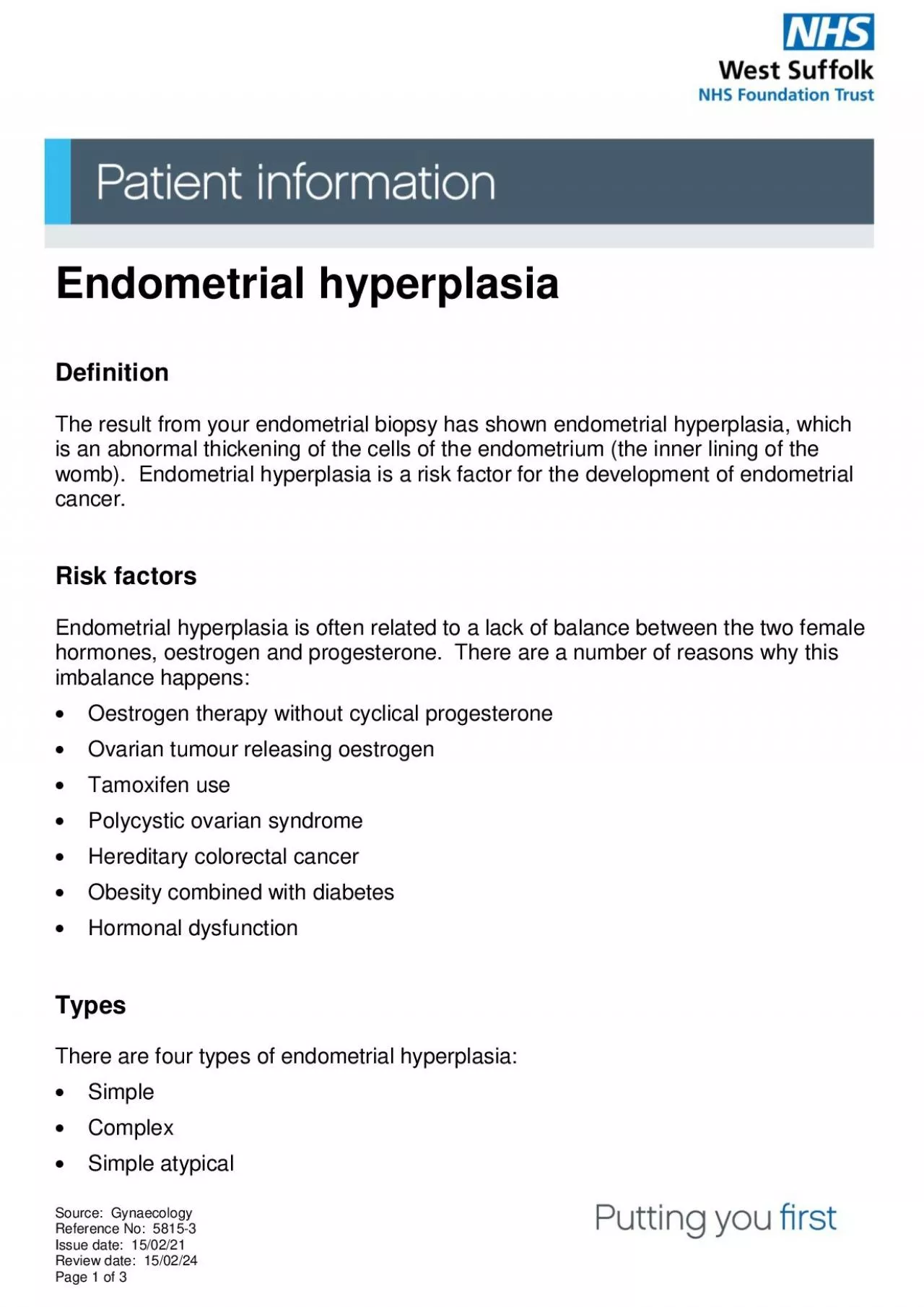

logy Reference No 5815 3 Issue date 150221 Review date 150224 Page 1 of 3 Endometrial h yperplasia Definition The result from your endometrial biopsy has shown endometrial hyperplasia whi ID: 953147
Download Pdf The PPT/PDF document "Source Gynaeco" is the property of its rightful owner. Permission is granted to download and print the materials on this web site for personal, non-commercial use only, and to display it on your personal computer provided you do not modify the materials and that you retain all copyright notices contained in the materials. By downloading content from our website, you accept the terms of this agreement.
Source: Gynaeco logy Reference No: 5815 - 3 Issue date: 15/02/21 Review date: 15/02/24 Page 1 of 3 Endometrial h yperplasia Definition The result from your endometrial biopsy has shown endometrial hyperplasia, which is an abnormal thickening of the cells of the endometrium (the inner lining of the womb). Endometrial hyperplasia is a risk factor for th e development of endometrial cancer. Risk f actors Endometrial hyperplasia is often related to a lack of balance between the two female hormones, oestrogen and progesterone. There are a number of reasons why this imbalance happens: ⢠Oestrogen therapy with out cyclical progesterone ⢠Ovarian tumour releasing oestrogen ⢠Tamoxifen use ⢠Polycystic ovarian syndrome ⢠Hereditary colorectal cancer ⢠Obesity combined with diabetes ⢠Hormonal dysfunction Types There are four types of endometrial hyperplasia: ⢠Simple ⢠Comple x ⢠Simple atypical Page 2 of 3 ⢠Complex atypical âSimpleâ refers to cystic expansion of the glands within the endometrium and âcomplexâ to crowding and budding of the glands. It is reported that 90% of cases of simple and complex hyperplasia, without atypi
cal change, return to normal endometrial structure spontaneously or with treatment with progestogens (hormones similar to p rogesterone). Atypical changes mean that the cells have changed in their architecture with more concerning features and present a high er risk of progressing into endometrial cancer. The risk of progression to cancer 1% of patients with simple hyperplasia 3% of patients with complex hyperplasia 8% of patients with simple atypical hyperplasia 29% of patients with complex atypical hyperpl asia Treatment of endometrial hyperplasia Endometrial hyperplasia can be treated. When planning treatment your doctor will take into account the following: ⢠the cause of the hyperplasia ⢠whether you have atypical cell changes ⢠your age and if you have been through the menopause ⢠whether you want to have children ⢠how fit you are to have an operation Simple hyperplasia without atypia responds to the hormone progesterone. This can be delivered by: ⢠Tablets: provera, primolut - N or similar ⢠Intra - uterine system (IUS): levonorgestrel. This is coil similar to one used for contraception. It has a progesterone - like hormone along its stem which is released locally, t
hinning out the lining of the womb. Page 3 of 3 A repeat biopsy will be taken in 3 - 6 months, in the clinic, to ensure that treatment is working. Atypical hyperplasia : A hysterectomy with removal of both tubes and ovaries is usually advised, due to the significant underlying risk of endometrial cancer. This risk of cancer is higher for women with hyperplasia w ho have been through the menopause. If you need any further advice / information please contact: Gynaecology n urses office : 01284 713154 Useful web links: www.cancerhelp.org.uk West Suffolk NHS Foundation Trust is actively involved in clinical research. Your doctor, clinical team or the research and development department may contact you regarding specific clinical research studies that you might be interested in p articipating in. If you do not wish to be contacted for these purposes, please email info.gov@wsh.nhs.uk . This will in no way affect the care or treatment you receive. If you would like any information regardi ng access to the West Suffolk Hospital and its facilities please visit the website for AccessAble (the new name for DisabledGo) https://www.accessable.co.uk © West Suffolk NHS Foundation Tru